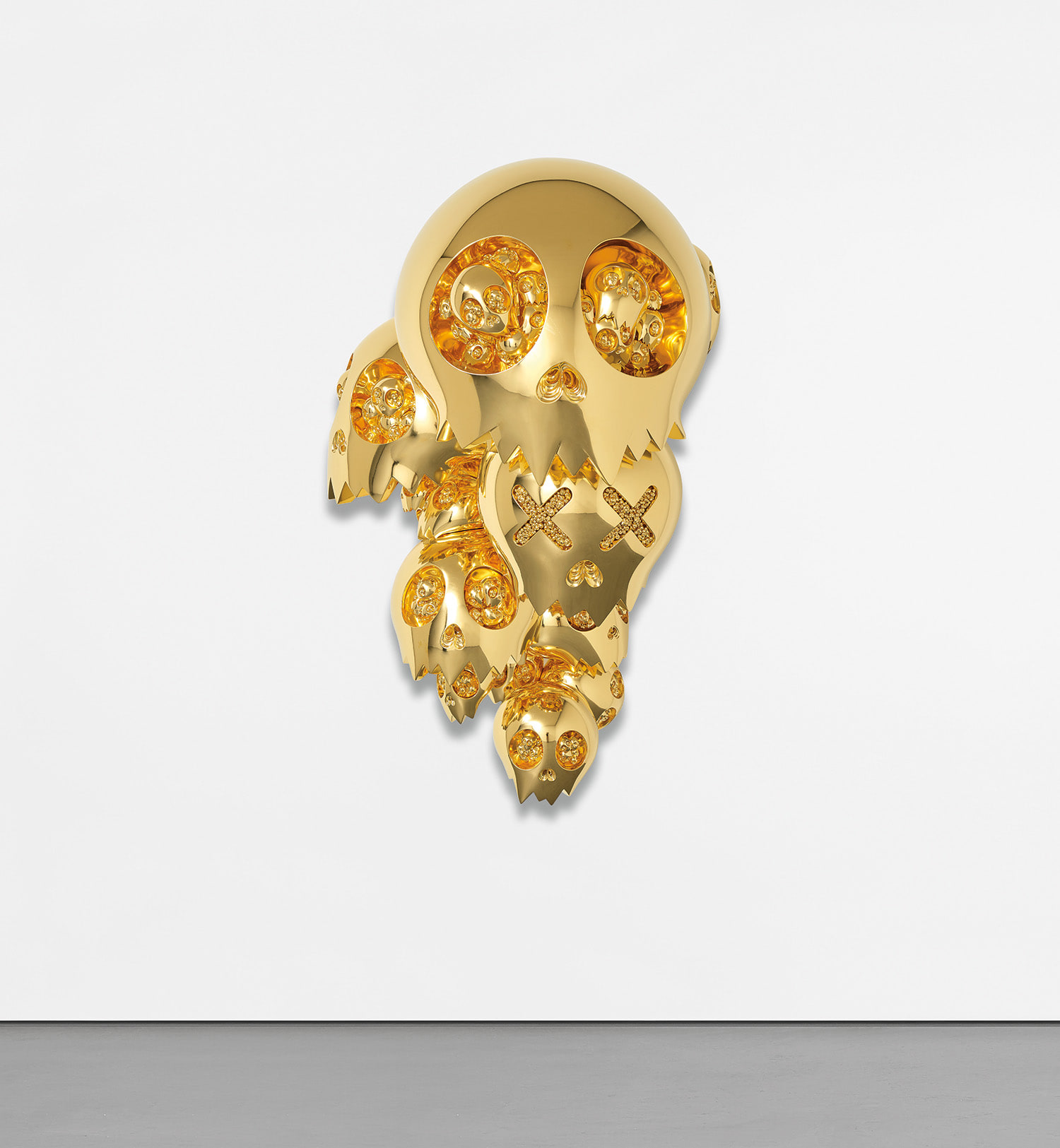

33
Takashi Murakami
Dragon Heads - Gold
Full-Cataloguing
Pairing Japanese tradition with a contemporary sheen, Murakami develops a symbiotic visual lexicon that dissolves the distinctions between high art and popular culture, contemporary production and ancient image-making. In doing so, the artist’s practice engages in an oscillatory conversation with the industries of fine art and fashion, producing paintings and sculptures which are as much works of art as they are coveted commercial icons. Whilst Pop artists Claes Oldenburg and Andy Warhol produced a satirical critique of capitalism and the increasingly consumerist culture of the art world, Murakami has flattened these boundaries, creating an art defined by bountiful excess.
Constituting one of several recurring character motifs from Murakami’s iconography, the skull has been a protagonist in the artist’s output for the past twenty years. The roundness with which the skulls are crafted in the present work confers the inert creatures an endearing charm, almost able to masquerade their symbolism as icons of death. Yet, as often in the traditions of kawaii and manga from which Murakami takes inspiration, there are deeper connotations that lurk beneath their innocent appearance. Elucidating this paradox, the artist noted, ‘Desire and death are always connected in some way, I believe, just as they are both an inextricable part of life. A thrill without danger is not a thrill’ (Takashi Murakami, quoted in Matthew Ponsford, 'Murakami in Ibiza: Can art's rule-breaker get ravers to a gallery?', CNN, 2 July 2015, online). In its juxtaposition of the themes of death and desire, danger and innocence, the dichotomy at the heart of Dragon Heads – Gold evokes Damien Hirst’s For the Love of God, which similarly employs the image of the skull, whilst casting it as tangibly sublime in its luxurious three-dimensional form. Echoing Murakami’s use of a precious material, Hirst’s sculpture presents the platinum cast of an 18th century skull encrusted with 8,601 diamonds.
Notably, Murakami departs from his signature Superflat style in Dragon Heads – Gold, veering instead towards the three-dimensional physicality of sculpture. Hung from the wall, the work eludes the flatness of Japanese graphic art and animation, and offers by contrast a commanding and charismatic presence. Almost surreal in form, Dragon Heads – Gold blurs the boundaries between that which is real and imagined, animate and inanimate, plunging the viewer into the realm of the fantastical. The visual experience prescribed by the work negates that of the sculpture of antiquity through to early modernity, which often demands the intricate inspection and careful contemplation of its audiences. Instead, it exists within a contemporary lineage that includes Jeff Koons’ glossy balloon animals, which equally allow an immediately gratifying experience to even the most fleeting of viewers. Murakami’s art, like Koons’, is curated for a contemporary audience – an audience whose interest is often heavily informed by the rapid proliferation of visual information made available by ever-developing technologies.
Transcending nationality, culture and time, Dragon Heads - Gold encapsulates Murakami’s development of an idiosyncratic visual lexicon constituted through references to the visual iconography of pop culture and mass media. In this sense, it is emblematic of the artist’s vision and intention, which has offered a new horizon for art in the 21st century.
Takashi Murakami
Japanese | 1962Takashi Murakami is best known for his contemporary combination of fine art and pop culture. He uses recognizable iconography like Mickey Mouse and cartoonish flowers and infuses it with Japanese culture. The result is a boldly colorful body of work that takes the shape of paintings, sculptures and animations.
In the 1990s, Murakami founded the Superflat movement in an attempt to expose the "shallow emptiness of Japanese consumer culture." The artist plays on the familiar aesthetic of mangas, Japanese-language comics, to render works that appear democratic and accessible, all the while denouncing the universality and unspecificity of consumer goods. True to form, Murakami has done collaborations with numerous brands and celebrities including Kanye West, Louis Vuitton, Pharrell Williams and Google.